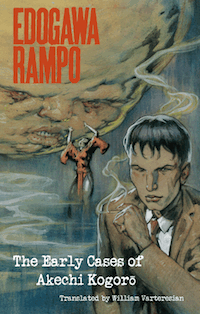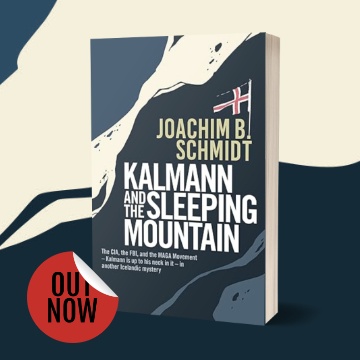Translated by William Varteresian — Edogawa Rampo was the pen name of Taro Hirai, a Japanese author active from 1923 until his death in 1965. He is known as the father of Japanese detective fiction and his work – particularly his early writing – proved that a tightly plotted work of detective fiction can be set in amongst the crowded tenements and paper walls of the world’s largest city. Hirai’s pen name, as well as being a reference to Edgar Allan Poe, whose work he admired, also refers to the Edo River (or Edo-gawa) which borders the area of Tokyo where many of his stories are set.
In addition to being at the forefront of Japanese detective fiction, Rampo’s work also changed with the times. Early on it was characteristic of the settling down and growth of the Taisho Era (1912-1926), a more settled period than the chaotic Meiji Era, when Japan looked outwards after centuries of isolation. Showcased in this collection, the writing bears a striking resemblance to Arthur Conan Doyle, as well the GK Chesterton and Edgar Allan Poe – all authors that Rampo would have been familiar with from literary magazines published in Japan at the time. In fact, Rampo’s characters themselves are devotees of western detective fiction, and the hero of these stories (who resembles a globetrotting yet penniless Sherlock Holmes) does not miss a chance to reference classic works of detective fiction, which at the time would have been contemporary.
The hero of these stories, Akechi Kogoro, lives a poor bachelor’s life in a lodging house in downtown Tokyo, in a room above a shop, where he lives surrounded by detective novels – so many that the narrator, the Watson to Kogoro’s Holmes, wonders where he sleeps. The haphazard piles of detective novels are the only furniture in Kogoro’s room, and the idiosyncratic detective refers to detective fiction, both Japanese and international, in the unraveling of the various mysteries in this collection. Kogoro seems well aware of his place in the history of detective fiction, and makes use of it, even once admonishing his friend-turned-assistant for jumping to conclusions as a result of reading too many detective novels.
In fact it is this self-awareness, this knowledge of its place in the history of detective fiction, which makes this collection most interesting. The introduction and translator’s notes provide a good background to the period when these works were written, and Rampo’s unique place in Japanese detective fiction.
The stories themselves are, the introduction admits, not Rampo’s best work. The Case of the Murder on D Hill is his attempt at a locked room mystery set in Japan, the story which introduced Japanese readers to Akechi Kogoro, and is probably the stand out in this collection. The Black Hand Gang is interesting, although the unfolding of the plot relies heavily on a code written in Japanese script. William Varteresian does well to explain this in a way that hopefully replicates the experience the original readers would have felt, but those unfamiliar with Japanese will have to think quite hard to understand the code. The third story, The Ghost, shows a little more of Rampo’s fascination with the grotesque and supernatural, but the climax is, like much of Rampo’s work, classic golden age with a psychological twist.
The final story, The Dwarf, is the weakest, and unfortunately also the longest. This Jekyll and Hyde tale of an evil dwarf taking advantage of a family’s unfortunate circumstances has two failings – the first is that it hasn’t aged well, and the second is that it is too long. It’s worth sticking through to the end though, as the climax is surprising, and the great golden age moments are really interesting, both for the perspective they give on Japan at the time, as well as the history of crime fiction.
This collection is not the best introduction to Rampo’s dynamic body of work – that honour may go to The Edogawa Rampo Reader, also published by Kurodahan – but it is interesting in the way that the readable but authentic translation provides a unique insight into the period, and the history of Japanese crime fiction.
Kurodahan Press
Paperback
£11.50
CFL Rating: 4 Stars










